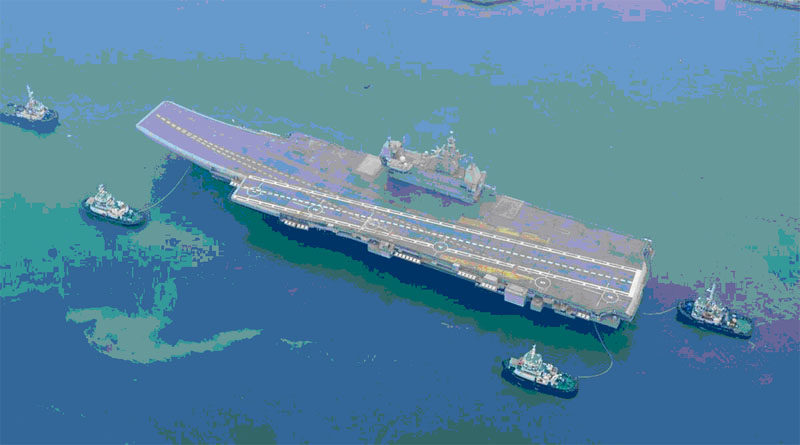India’s First Indigenous Aircraft Carrier Begins Next Phase Of Sea Trials
January 9, 2022
IAC-1, which will be called INS Vikrant once it enters service with the Navy, successfully completed a five-day maiden sea voyage in August and underwent 10-day sea trials in October. The warship has been built at a cost of around Rs 23,000 crore and its construction propelled India into a select group of countries having capabilities to build state-of-the-art aircraft carriers.
The Indigenous Aircraft Carrier (IAC) 1, which will be called INS Vikrant once it enters service with the Indian Navy, began another set of sea trials on Sunday to carry out complex manoeuvres in high seas ahead of its planned induction in August.
The 40,000-tonne aircraft carrier, the largest and most complex warship to be built in India, successfully completed a five-day maiden sea voyage in August and underwent 10-day sea trials in October.
“The IAC now sails to undertake complex manoeuvres to establish specific readings of how the ship performs in various conditions,” Navy spokesperson Commander Vivek Madhwal was quoted as saying by news agency PTI.
“After two successive high profile visits, the President and Vice President of India, within a span of less than two weeks, IAC Vikrant is heading out for the next set of sea trials,” Commander Madhwal said.
“Both dignitaries, having reviewed the progress, had conveyed their satisfaction and expressed their best wishes to all the stakeholders involved in the project,” he added.
The keel of the 40,000-tonne warship was laid in February 2009, and it was floated out at Cochin Shipyard Ltd (CSL), which has built it, in December 2011. Basin trials were completed in November 2020, and the vessel is expected to be commissioned into the Navy by August 2022.
According to the Navy, IAC-1 will operate the Russian-built MiG-29K fighter aircraft and Kamov-31 air early warning helicopters; the indigenously manufactured Advanced Light Helicopters (ALH); and the soon-to-be-inducted MH-60R multirole helicopters manufactured by Lockheed Martin.
The warship has been built at a cost of around Rs 23,000 crore and its construction propelled India into a select group of countries having capabilities to build state-of-the-art aircraft carriers.
President Ram Nath Kovind and Vice President M Venkaiah Naidu visited the ship recently in Kochi.
While the maiden sea trials were to establish propulsion, navigational suite and basic operations, the second sea trial witnessed the ship being put through its paces in terms of various machinery trials and flight trials.
Several scientists from the Naval Science and Technological Laboratory, a DRDO facility based at Visakhapatnam, are witnessing the third phase of sea trials of Vikrant.
The warship will operate MiG-29K fighter jets, Kamov-31 helicopters, MH-60R multi-role helicopters.
It has over 2,300 compartments, designed for a crew of around 1700 personnel, including specialised cabins to accommodate women officers.
Vikrant has a top speed of around 28 knots and a cruising speed of 18 knots with an endurance of about 7,500 nautical miles, officials said.
The IAC is 262 metres long, 62 metres wide and it has a height of 59 metres. Its construction began in 2009.
India’s sole aircraft carrier at the moment is the Russian-origin INS Vikramaditya, which entered service in 2013. The Navy is looking at deploying 36 multirole fighter aircraft that will cater to both the Vikramaditya and the new Vikrant.
The Navy has also been pushing for a bigger, 65,000-tonne warship, but the government is still weighing the need for a third aircraft carrier. The Navy feels a third carrier is an operational necessity — Chief of the Naval Staff Admiral Karambir Singh had said on Navy Day (December 3) last year that the Navy did not want to stay “tethered to the shore”, and “air power at sea is absolutely required”.
(With PTI inputs)
Courtesy: IE

